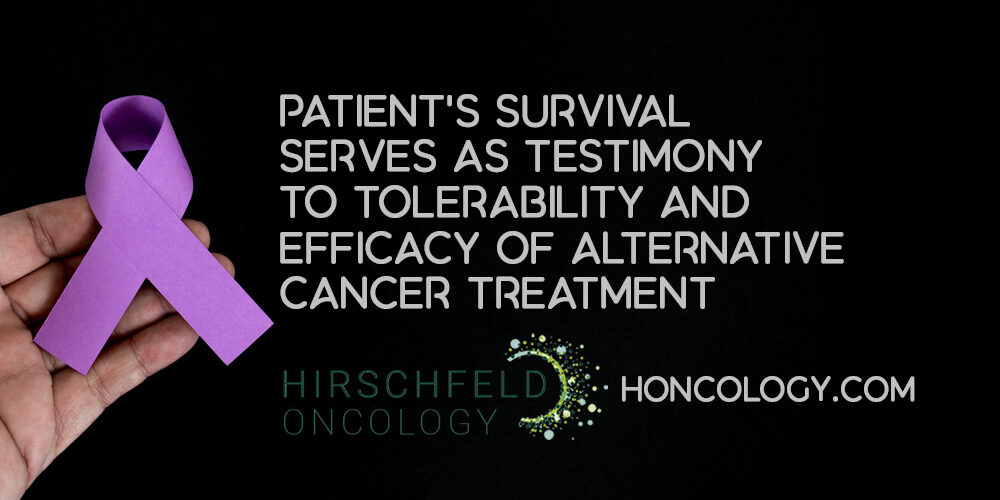Introduction to Low-Dose Multi-Drug Chemotherapy Protocols
Overview of low-dose chemotherapy and multi-drug approaches
Low-dose chemotherapy, often known as metronomic chemotherapy, involves administering chemotherapeutic drugs at significantly lower doses but more frequently than traditional protocols. This method may be combined with multi-drug regimens targeting various cancer pathways simultaneously for improved treatment outcomes. Multi-drug approaches take advantage of synergistic effects by attacking tumor cells through different mechanisms and reducing the chance of drug resistance.
Rationale for using low-dose regimens in cancer treatment
Traditional chemotherapy focuses on using the maximum tolerated dose to kill cancer cells; however, this often causes severe side effects and toxicity. Low-dose protocols aim to maintain effectiveness while minimizing adverse effects by normalizing tumor blood vessels to enhance drug delivery and oxygen supply, promoting immune system activation. The approach also targets the tumor microenvironment, helping to suppress resistant and stem-like cancer cells, thus improving therapeutic response.
Benefits over traditional chemotherapy protocols
Low-dose multi-drug chemotherapy has shown advantages including reduced toxicity and fewer side effects, better quality of life, and potentially longer-lasting tumor control. The approach decreases treatment-related toxicities by avoiding dose-limiting toxicity typical of standard high-dose chemotherapy. Additionally, by modulating the immune system and tumor vasculature, it may enhance antitumor immunity and drug penetration, making treatment more effective and tolerable for patients.
The Scientific Foundation of Low-Dose Chemotherapy

Principles of Metronomic Chemotherapy
Low-dose chemotherapy, also known as metronomic chemotherapy, involves administering chemotherapeutic drugs at lower doses but with greater frequency compared to traditional protocols. This approach aims to minimize toxicity while maintaining therapeutic efficacy, fundamentally differing from maximum tolerated dose strategies that emphasize high-dose treatments with longer recovery periods.
Normalization of Tumor Vasculature
A central mechanism of metronomic chemotherapy is the 'normalization of tumor blood vessels.' Unlike traditional angiogenesis, tumor vasculature is often irregular and leaky, impairing effective drug delivery and immune cell infiltration. By improving the structure and function of these blood vessels, metronomic chemotherapy enhances oxygen supply and facilitates the delivery of drugs, maximizing their impact while reducing side effects.
Mathematical Modeling of Treatment Effects
Recent mathematical models of treatment effects in chemotherapy have been developed to analyze the complex interplay among cancer cells, immune cells, and tumor blood vessels. These models demonstrate that vascular normalization is essential for the beneficial effects of metronomic chemotherapy. They also highlight that optimal treatment schedules should maintain intervals between doses at less than 40% of the tumor's recovery time to prevent tumor regrowth. Modeling guides the tailoring of dosing and scheduling, enabling a more personalized and effective therapy.
Role of Immune Modulation in Low-Dose Protocols
Low-dose chemotherapy influences the tumor microenvironment by not only directly attacking cancer cells but also modulating immune responses. It boosts immune activity by reducing populations of immunosuppressive cells and enhancing the function of effector T cells and natural killer (NK) cells. This dual action fosters a more hostile environment for tumors, complementing drug delivery improvements through vessel normalization (Chemo-Immunotherapy in Cancer Treatment).
Through this integrated effect on vasculature and immune modulation, low-dose chemotherapy protocols offer a scientifically grounded strategy aimed at improving outcomes while minimizing adverse effects in cancer treatment.
Advantages of Multi-Targeted Drug Therapies in Cancer Treatment

Addressing Tumor Heterogeneity and Drug Resistance
Cancer tumors often exhibit clonal heterogeneity, meaning different populations of cancer cells within a tumor can behave and respond differently to treatments. This diversity contributes significantly to drug resistance, a major challenge in cancer therapy. Multi-target cancer therapies are designed to simultaneously attack multiple molecular targets or pathways within cancer cells, effectively overcoming this heterogeneity. By inhibiting several routes that tumors use to survive and grow, these therapies reduce the likelihood that cancer cells will adapt or develop resistance.
Mechanisms by Which Multi-Target Drugs Enhance Efficacy
Multi-target drugs synergize their effects by interfering with multiple signaling cascades critical to cancer progression. They can inhibit growth factor receptors, block pro-survival signaling, and disrupt pathways responsible for angiogenesis and immune evasion. This broad inhibition improves overall treatment efficacy, reduces tumor progression, and limits the emergence of resistant clones. Additionally, such drugs tend to lower systemic toxicity and side effects by enabling dose reductions while maintaining therapeutic potency. For insights on dose strategies, see Dose optimization in cancer drug development.
FDA-Approved Multi-Target Kinase Inhibitors
Several multi-targeted kinase inhibitors have received FDA approval, reflecting their therapeutic value in oncology. Examples include:
| Drug Name | Targets | Clinical Use |
|---|---|---|
| Imatinib | BCR-ABL, PDGFR, KIT | Chronic myeloid leukemia, GIST |
| Lapatinib | HER2, EGFR | HER2-positive breast cancer |
| Sorafenib | VEGFR, PDGFR, RAF kinases | Renal cell carcinoma, hepatocellular carcinoma |
| Sunitinib | VEGFR, PDGFR, KIT | Renal cell carcinoma, GIST |
| Vandetanib | VEGFR, EGFR, RET | Medullary thyroid cancer |
These drugs collectively target pathways essential for tumor growth, angiogenesis, and metastasis. See also FDA-approved multi-target cancer drugs for a broader overview.
Pathways Targeted by Multi-Target Drugs
Multi-target therapies primarily focus on critical signaling pathways that regulate cancer cell survival, proliferation, and invasion. Key pathways targeted include:
- Receptor Tyrosine Kinases (RTKs): EGFR, HER2, VEGFR, PDGFR, FGFR, RET, ALK, ROS1
- JAK/STAT Pathway: Modulates immune responses and cell proliferation
- NF-κB Pathway: Controls inflammation, cell survival, and resistance mechanisms
Targeting these interconnected pathways offers a comprehensive strategy to disrupt cancer development and progression simultaneously. For more details, see targeting RTKs in cancer, JAK/STAT pathway in cancer, and NF-κB role in cancer progression.
In summary, multi-targeted drug therapies represent an advanced approach in cancer treatment by effectively managing tumor heterogeneity, enhancing treatment efficacy through multi-pathway inhibition, and reducing side effects. Continued FDA approvals and scientific advances support their vital role in modern oncology.
Emerging Multi-Targeted Agents and Combination Strategies

How are multi-target drugs designed in cancer treatment?
Multi-target drugs (MTDLs) are engineered using several innovative design strategies for multi-target drugs to attack multiple cancer-related pathways simultaneously. These strategies include:
- Scaffold combining: blending distinct pharmacophore structures into one molecular framework.
- Fusion: integrating active components into a single hybrid molecule.
- Merging: overlapping pharmacophores that share common features.
- Linking: chemically joining different pharmacophores to maintain multi-functionality.
These approaches help create therapies that can combat tumor heterogeneity and drug resistance more effectively than single-target drugs.
What are key target receptors involved in these therapies?
MTDLs typically inhibit several receptor tyrosine kinases (RTKs) and other molecular targets critical for cancer progression, including:
- EGFR (Epidermal Growth Factor Receptor)
- HER2 (Human Epidermal growth factor Receptor 2)
- VEGFR (Vascular Endothelial Growth Factor Receptor)
- PDGFR (Platelet-Derived Growth Factor Receptor)
- ALK (Anaplastic Lymphoma Kinase)
- RET, FGFR, C-MET, ROS1
Drugs like imatinib, lapatinib, sorafenib, and sunitinib target these receptors to disrupt tumor cell signaling and angiogenesis, improving patient outcomes in cancers such as non-small cell lung carcinoma, renal cell carcinoma, and breast cancer.
What challenges exist in the development of multi-target agents?
Despite their promise, MTDLs face notable hurdles:
- Pharmacokinetics: Achieving optimal absorption, distribution, metabolism, and excretion profiles is complex because multiple targets require balanced activity.
- Toxicity: Simultaneous inhibition of multiple pathways can increase off-target effects and adverse reactions, necessitating careful dose optimization in cancer drug development.
- Drug resistance: Although designed to reduce resistance, tumors may still adapt via alternative signaling routes.
These challenges require sophisticated preclinical models and clinical trial designs to identify safe and effective dosing regimens.
What future trends are shaping multi-target drug development?
The field is rapidly evolving with exciting innovations:
- Artificial Intelligence (AI): AI-driven multi-target drug development accelerates the identification and optimization of multi-target compounds by predicting interactions and efficacy.
- Peptide-based therapies: Peptide-based multi-target drugs can offer high specificity with potentially lower toxicity, opening avenues for novel MTDLs.
- Integrated drug design: Combining AI, structure elucidation, and high-throughput screening allows the creation of highly tailored drugs.
These advances aim to enhance precision oncology, improving treatment success rates while minimizing side effects.
Dose Optimization: Shifting Beyond Maximum Tolerated Dose

What Are the Limitations of the Maximum Tolerated Dose (MTD) Concept?
Traditional cancer drug development has predominantly relied on the maximum tolerated dose (MTD) model, which focuses on administering the highest dose a patient can tolerate without severe toxicity. While this approach was suitable for classic cytotoxic chemotherapy, it is less appropriate for modern targeted therapies and immunotherapies.
MTD-based dosing often leads to unnecessary side effects without improving efficacy for many targeted agents, as these drugs frequently reach therapeutic effects well below their MTD. Moreover, the emphasis on short-term dose-limiting toxicities (DLTs) fails to capture long-term tolerability issues, which are critical for chronic treatments (Dose optimization in cancer drug development).
What Is the Concept of Optimal Biological Dose (OBD)?
The optimal biological dose (OBD) represents a dose that balances maximal therapeutic effect with minimal adverse events. Instead of pushing doses to toxicity limits, OBD focuses on dosing that achieves target saturation or the maximal pharmacodynamic response, often at lower and safer dose levels (Optimal biological dose concept.
This paradigm shift promotes better patient quality of life and reduces healthcare costs by minimizing overexposure to drugs. The OBD approach acknowledges that "more is not always better," especially for therapies aiming at specific molecular targets or immune modulation (Dose optimization and balancing efficacy and tolerability.
How Is FDA's Project Optimus Influencing Dose Optimization?
The FDA launched Project Optimus to overhaul dose-finding in oncology drug development. The initiative mandates randomized, dose-response clinical trials before approval, aiming to accurately determine optimal dosing rather than defaulting to MTD.
Project Optimus encourages comprehensive study designs integrating multiple endpoints and emphasizes the importance of early dose optimization to improve efficacy and limit toxicities. It also fosters the use of pharmacokinetic/pharmacodynamic (PK/PD) modeling, biomarkers, and patient-reported outcomes to guide dose selection.
Why Are Pharmacokinetics, Pharmacodynamics, and Biomarkers Important?
Pharmacokinetic (PK) and pharmacodynamic (PD) analyses provide critical information on how a drug is absorbed, distributed, metabolized, and interacts with targets in the body. These data help determine the dose associated with sufficient target engagement and biological activity (Pharmacokinetic/pharmacodynamic modeling in dose selection.
Biomarkers, including receptor occupancy and pharmacodynamic markers, serve as indicators of drug effect and aid in fine-tuning dosing to maximize benefit while minimizing harm. Combined with patient-reported outcomes, these tools offer a patient-centric approach to optimize long-term tolerability and efficacy.
New clinical trial designs now incorporate PK/PD modeling and biomarker assessments to personalize therapy, better distinguishing effective dose ranges and avoiding unnecessary toxicity (FDA’s Project Optimus and new trial designs.
In summary, the ongoing shift from MTD to OBD, driven by regulatory changes and advanced scientific tools, aims to refine cancer drug dosing for safer, more effective, and patient-friendly treatments.
Clinical Implications of Dose-Finding Innovations in Cancer Therapy

Why are randomized dose-response studies and adaptive clinical trial designs important?
Randomized dose-response studies are increasingly emphasized to identify the best therapeutic dose that balances safety and efficacy. Regulatory initiatives like the FDA's Project Optimus advocate these studies to move beyond traditional maximum tolerated dose (MTD) approaches. Adaptive trial designs enable flexible, efficient exploration of multiple dose levels and schedules within a single trial, allowing real-time adjustments based on emerging data. This adaptability improves dose precision and patient safety during drug development.
How do patient-reported outcomes (PROs) influence dose selection?
Incorporating PROs into dose-finding trials provides crucial insights into how patients tolerate treatments over time. Longitudinal PRO assessments detect persistent toxicities and quality-of-life impacts beyond traditional short-term toxicity measures, guiding dose adjustments that optimize tolerability. Using PRO tools alongside pharmacokinetic and pharmacodynamic data ensures doses maximize therapeutic benefit without compromising patient comfort (Dose optimization in cancer drug development.
What role does long-term tolerability play in managing toxicity?
Targeted therapies and immunotherapies often exhibit toxicities that emerge or persist beyond initial treatment cycles. Long-term tolerability assessment is vital to avoid under- or overdosing, which can respectively reduce efficacy or cause unnecessary side effects. Careful monitoring and dose modifications tailored to toxicity profiles enable sustained treatment adherence and better clinical outcomes (Dose optimization in cancer drug development.
What challenges exist in dose optimization for multi-drug combinations?
Multi-drug regimens complicate dose-finding due to drug-drug interactions and overlapping toxicities. Optimizing doses requires comprehensive trial designs that evaluate combined pharmacodynamics and toxicities. Adaptive models and biomarker-guided approaches help navigate the complex interplay between agents to identify safe, effective dosing combinations. Coordinating dose modifications to maintain synergy while minimizing adverse effects remains an ongoing challenge (Randomized dose-response studies and biomarker-guided dose optimization.
Advancements in dose-finding methodologies herald a shift toward personalized, data-driven dosing strategies that improve patient outcomes and safety in cancer therapy (Cancer drug dose optimization and FDA guidance).
Chemo-Immunotherapy: Enhancing Immune Response at Low Doses
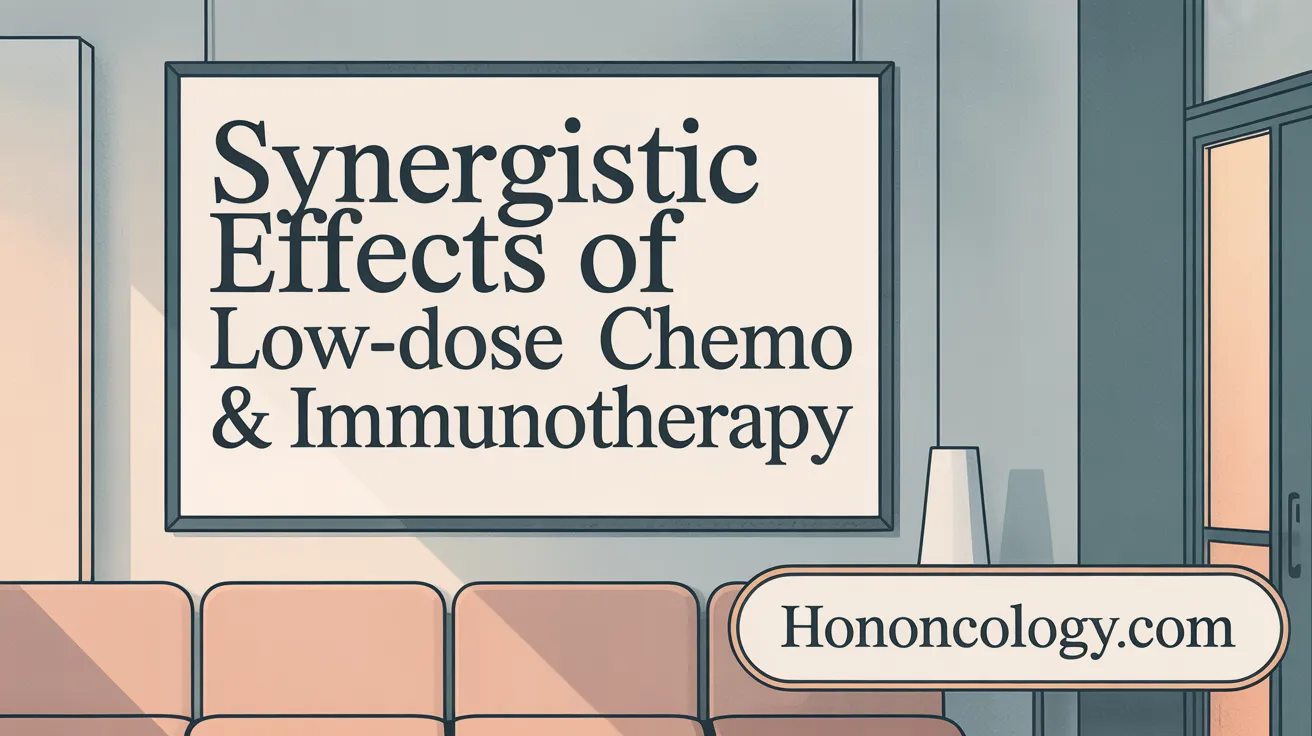
How does chemotherapy induce immunogenic cell death (ICD)?
Certain chemotherapeutic drugs can trigger immunogenic cell death (ICD), a process that enhances the body's antitumor immune response. ICD promotes antigen presentation by dendritic cells and activates cytotoxic T lymphocytes through the release of danger-associated molecular patterns (DAMPs) such as ATP, calreticulin, and HMGB1. Drugs like anthracyclines, taxanes, cyclophosphamide, oxaliplatin, and cisplatin are known to induce ICD, fostering a more effective immune attack against cancer cells (Chemo-Immunotherapy in Cancer Treatment.
How does low-dose chemotherapy reduce immunosuppressive cells?
Low doses of chemotherapy, sometimes referred to as metronomic chemotherapy, selectively reduce immunosuppressive populations within the tumor microenvironment. It decreases regulatory T cells (Tregs) and myeloid-derived suppressor cells (MDSCs), which often inhibit immune activation. This reduction enhances the activity of immune effector cells such as natural killer (NK) cells and cytotoxic T cells, contributing to a robust antitumor immune response (Chemo-Immunotherapy in Cancer Treatment; Low-dose chemotherapy protocol relies on normalisation of tumour blood supply).
What are the benefits of combining chemotherapy with immune checkpoint inhibitors?
Combining chemotherapy with immune checkpoint inhibitors (ICIs) has demonstrated synergistic effects. Chemotherapy's ability to promote ICD and modulate immune suppressive cells complements the immune-boosting action of ICIs, such as PD-1/PD-L1 blockers. These combinations have been approved in clinical settings for cancers including non-small cell lung cancer and triple-negative breast cancer, resulting in improved survival rates and response (Chemo-Immunotherapy in Cancer Treatment; Targeted cancer therapies including immune checkpoint inhibitors).
Why is timing and sequencing critical in chemo-immunotherapy?
The effectiveness of chemo-immunotherapy hinges on optimal timing and sequencing. Administering immunotherapy before or after chemotherapy can differentially influence treatment success. Proper scheduling maximizes immune activation, minimizes adverse effects, and potentiates the synergy between treatments. Research indicates that the dose and sequence profoundly affect the immune microenvironment and treatment outcomes, underscoring the need for personalized protocols (Chemo-Immunotherapy in Cancer Treatment; Clinical Approval of Chemo-Immunotherapy.
Novel Low-Dose Regimens Driving Tumor Microenvironment Modulation

How does low-dose chemotherapy affect tumor blood vessels and oxygenation?
Low-dose chemotherapy, also known as metronomic chemotherapy, involves frequent administration of chemotherapy at doses much lower than traditional levels. This approach promotes the normalization of blood vessels within and around tumors. Vascular normalization improves the structure and function of tumor blood vessels, allowing for better delivery of chemotherapy drugs and oxygen to the tumor tissue. Enhanced oxygenation also supports more effective treatment responses.
How does low-dose chemotherapy stimulate immune activity within tumors?
Improved vasculature increases immune cell infiltration and activity inside the tumor microenvironment. Low-dose chemotherapy can reduce immunosuppressive cells such as regulatory T cells and myeloid-derived suppressor cells, while simultaneously activating immune effector cells like natural killer (NK) cells and cytotoxic T lymphocytes. This shifting immune landscape helps the body's defenses better target cancer cells. See more on Chemo-Immunotherapy in Cancer Treatment.
In what ways does this approach decrease the proliferation of stem-like, drug-resistant cancer cells?
By normalizing tumor blood vessels and enhancing immune responses, low-dose chemotherapy environment limits the growth and renewal of cancer stem-like cells, which are often responsible for therapy resistance and tumor relapse. The improved oxygen and drug supply, combined with boosted immune clearance, reduces the capacity of these resistant cells to survive and expand. Further details on tumor microenvironment and chemotherapy.
What insights does mathematical modeling provide about treatment timing and vascular normalization?
Mathematical modeling of treatment effects in chemotherapy incorporating interactions among cancer cells, immune cells, and blood vessels show that vascular normalization is crucial for treatment success. Optimal scheduling of low-dose chemotherapy requires treatment intervals no longer than 40% of the tumor's recovery time to sustain vascular normalization and prevent tumor regrowth. Imaging techniques such as MR or ultra-CT can assess vessel normalization, enabling personalized dosing schedules that maximize efficacy and minimize side effects. For more, see Low-dose chemotherapy and mathematical modeling.
This integrated understanding supports the potential of low-dose chemotherapy protocols to modulate the tumor microenvironment effectively, improving drug delivery and immune-mediated tumor control while preventing resistance.
Case Study: Low-Dose Chemotherapy Combined with Delayed Immunotherapy in NSCLC
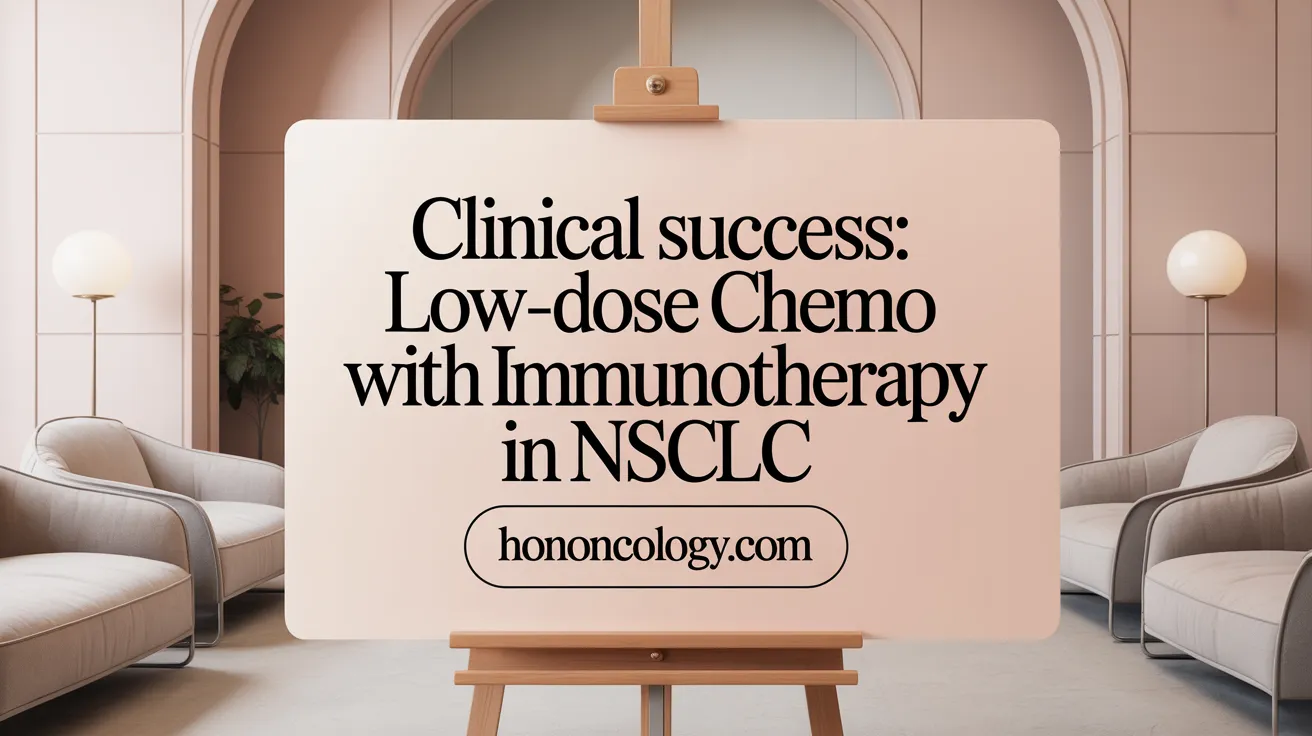
Clinical Trial Design and Patient Criteria
A pilot clinical trial evaluated the combination of low-dose platinum-based chemotherapy with delayed immunotherapy in patients with resectable non-small cell lung cancer (NSCLC). Participants included those with clinical stage IIA to IIIA disease who were treatment-naïve with measurable tumors. Patients had no known mutations in EGFR or ALK, ensuring eligibility for the combined treatment approach as detailed in the low-dose chemotherapy for NSCLC study.
Efficacy Endpoints Including Objective Response and Pathologic Response
The trial reported a high objective response rate (ORR) of 73.7%, with 5.3% achieving complete remission and 68.4% partial responses. Tumor downstaging occurred in 74.2% of patients, and nearly half (47.4%) experienced a major pathological response. Additionally, 31.6% attained a pathologic complete response (pCR), indicating substantial tumor eradication before surgery, consistent with outcomes observed in low-dose platinum-based chemo-immunotherapy regimens.
Immunological Findings Such as T-Cell Receptor Clone Expansion
Analysis of immune responses revealed expansion of T cell receptor (TCR) clones during neoadjuvant therapy. This was observed as a peak in predominant TCR clone frequencies after administration of low-dose chemotherapy and delayed immunotherapy. Circulating tumor DNA (ctDNA) levels declined notably, suggesting a reduced tumor burden and enhanced immune activation during treatment, in alignment with mechanisms discussed in Chemo-Immunotherapy in Cancer Treatment and related immunological evaluations.
Safety Profile and Toxicity Outcomes
The treatment regimen demonstrated a favorable safety profile with minimal toxicity. Only one grade 3 adverse event was reported, reflecting low treatment-related side effects. This reduced toxicity supports the feasibility of combining low-dose chemotherapy with immunotherapy while preserving patient tolerance and quality of life, reinforcing themes from low-dose chemotherapy protocols and dose optimization strategies in cancer drug development.
Innovative Drug Delivery Systems to Enhance Low-Dose Chemotherapy

Nanoparticle-Based Targeted Delivery Using Patient’s Immune Cells
A novel approach leverages the patient's own T cells as carriers for chemotherapy drugs, providing a 'Trojan horse' method to deliver treatment precisely to tumor sites. Researchers isolate T-cell membranes, load them with chemotherapy agents such as Cisplatin, and coat nanoparticles with these membranes. This design allows nanoparticles to mimic immune cells, effectively evading the body's defense systems and concentrating the chemotherapy in cancerous tissues (innovative chemotherapy approach).
Mechanisms to Minimize Off-Target Toxicity
By camouflaging the drug-loaded nanoparticles with immune cell membranes, this method minimizes exposure of healthy cells to toxic chemotherapy agents, thereby reducing common side effects associated with traditional treatment. The immune cell mimicry ensures selective accumulation at tumor locations, sparing normal tissues and improving the patient’s quality of life (Innovations in chemotherapy).
Clinical Promise in Lung Cancer Models
Preclinical studies using this targeted delivery system in lung cancer models demonstrated significant tumor accumulation and size reduction. This strategy successfully focused chemotherapy doses on tumors, enhancing antitumor efficacy while mitigating systemic toxicity, marking a promising step forward in cancer treatment (low-dose chemotherapy for NSCLC).
Personalized Drug Delivery Approaches
This delivery technology embodies the concept of personalized medicine by adapting treatment to the patient’s unique immune cells, potentially improving therapeutic outcomes. It opens doors for tailored chemotherapy regimens that maximize effectiveness and safety, highlighting the future of low-dose chemotherapy protocols integrated with precision drug delivery systems (Combination cancer therapies).
Machine Learning and Automation in Optimizing Multi-Drug Regimens

Microfluidic tumor-on-a-chip platforms and organoid models
To better understand the response of cancer cells to multi-drug therapies, researchers use microfluidic tumor-on-a-chip platforms. These devices simulate the physiological flow conditions found in human tissues and can culture breast cancer spheroids as well as patient-derived organoids. This approach allows for a more realistic evaluation of how tumors react to different drug combinations in a controlled environment.
Bayesian optimization for drug dose, sequence, and timing
A key innovation in this research is the use of Bayesian optimization algorithms, such as Gryffin, which efficiently explore complex multidimensional treatment parameters. By iteratively testing and learning from each experimental outcome, this framework optimizes drug doses, administration sequences, and timing to identify the most effective regimens with fewer required experiments.
Identification of low-dose multidrug combinations maintaining efficacy
Using this integrated system, studies have discovered three-drug combinations involving agents like 5-FU, doxorubicin, and cyclophosphamide that significantly lower the total drug dose—sometimes by up to 75%—without compromising cancer cell killing effectiveness. The findings suggest that sequential drug administration can maximize therapeutic impact while reducing toxicity associated with higher doses (Dose optimization in cancer drug development.
Potential applications in personalized oncology
This platform holds promise for personalized medicine, enabling preclinical testing of optimized drug combinations on patient-specific tumor organoids. By tailoring treatment regimens to individual tumor biology, it offers a path to safer, more effective multi-drug cancer therapies that balance efficacy and tolerability.
Clinical Trial Advancements in Low-Dose Immunotherapy and Chemotherapy Combinations

Description of ongoing randomized phase III trials combining low-dose checkpoint inhibitors with chemotherapy
Several ongoing phase III clinical trials are evaluating the safety and efficacy of combining low-dose immune checkpoint inhibitors with standard chemotherapy regimens, especially in non-small cell lung cancer (NSCLC) populations. One notable example is a multicenter, randomized, parallel-group study assessing low-dose nivolumab (40 mg) combined with chemotherapy versus chemotherapy alone. This trial targets treatment-naïve patients with locally advanced or metastatic NSCLC who have confirmed PD-L1 expression and meet specific performance and organ function criteria.
Endpoints like progression-free and overall survival
The primary outcome measure in these trials is typically progression-free survival (PFS), which tracks the length of time from randomization until disease progression or death, allowing assessment of the combination treatment's effectiveness. Secondary endpoints include overall survival (OS), providing long-term data on patient mortality benefits. Monitoring safety through adverse event rates and treatment discontinuations is also a critical component of evaluating these combination therapies.
Use of validated patient-reported outcome instruments
An important addition to these trials is the incorporation of patient-reported outcome (PRO) measures using validated tools such as the EORTC QLQ-C30, EQ-5D-5L, and NSCLC-SAQ questionnaires. These instruments capture patient perspectives on symptoms, quality of life, and functional well-being, which complement clinical endpoints to provide a holistic assessment of treatment impact and tolerability.
Focus on NSCLC populations
The focus on NSCLC populations is due to the disease's high prevalence and unmet need for improved therapies with manageable side effect profiles. By combining low-dose nivolumab with chemotherapy, researchers aim to optimize the therapeutic window—maintaining or improving efficacy while potentially reducing toxicity compared to conventional dosing strategies. These trials often exclude patients with EGFR, ALK, or ROS1 mutations to ensure homogeneous study populations and clearer interpretation of immunotherapy benefits in EGFR/ALK/ROS1 wild-type disease.
These cutting-edge trials reflect the shifting paradigm towards dose optimization in cancer drug development and combination strategies in cancer immunotherapy, supported by regulatory initiatives like FDA's Project Optimus, aiming to enhance treatment efficacy and patient quality of life.
Reducing Toxicities through Dose Reduction: Evidence and Benefits

Clinical Evidence from Drugs like Palbociclib and Camonsertib
Recent studies highlight that certain cancer drugs remain effective at doses lower than traditionally used, improving patient outcomes. Palbociclib, a drug for metastatic breast cancer, shows efficacy even with dose reductions, leading to fewer side effects and enhanced quality of life. Similarly, clinical trials involving camonsertib, a targeted therapy, demonstrate that lower doses combined with treatment breaks maintain anti-cancer efficacy while reducing toxicity (Efforts to lower cancer drug doses, Palbociclib dose reduction improvements, Camonsertib lower dose clinical trial results, Randomized NSCLC treatment study).
Reduced Side Effects and Improved Patient Quality of Life
Lower doses often lead to a notable decrease in adverse events. Patients receiving these optimized doses experience better tolerance with fewer severe toxicities, allowing them to maintain daily activities and overall well-being. This shift addresses the traditional approach where dosing was based on the maximum tolerated dose, which often compromised quality of life due to high toxicity (Dose optimization in cancer drug development, FDA's Project Optimus guidance, Cancer clinical trial dose finding.
Cost-Effectiveness and Healthcare Utilization Impact
Dose reduction also has economic benefits by reducing medication-related costs and minimizing hospitalizations triggered by side effects. For instance, taking lower doses of drugs such as abiraterone with food can be cost-effective without compromising efficacy. This strategy decreases the burden on healthcare systems and allows for more sustainable cancer care delivery (Cost-effective cancer drug dosing, Abiraterone lower dosing with food.
Regulatory Encouragement to Re-Evaluate Dosing
The FDA's Project Optimus launched in 2021 underscores the need to revisit dosing paradigms through randomized dose-finding studies. This initiative encourages early-phase trials to determine optimal biological doses balancing efficacy and tolerability rather than defaulting to maximum tolerated doses (FDA's Project Optimus and dose-finding, New trial designs for dose selection.
Optimizing cancer drug dosing brings measurable benefits across clinical outcomes, patient experiences, and healthcare systems, marking a progressive trend in oncology treatment strategies.
FDA Initiatives Driving Safer, More Effective Dosing Strategies
What are the FDA's Project Optimus and Project Renewal directives?
Project Optimus, launched by the FDA in 2021, focuses on improving dose optimization in cancer drug development. It challenges the traditional maximum tolerated dose (MTD) limitations, promoting identification of the optimal biological dose (OBD) concept that balances efficacy and tolerability. Similarly, Project Renewal aims to reevaluate dosing regimens of existing cancer drugs to improve safety and effectiveness through updated evidence and clinical data (Efforts to lower cancer drug doses.
How does the FDA encourage randomized, dose-ranging studies?
The FDA’s initiatives emphasize conducting randomized dose-response studies early in drug development. These studies help test multiple dose levels and dosing schedules to determine the safest and most effective doses. Incorporating pharmacokinetic/pharmacodynamic (PK/PD) modeling, use of biomarkers in dose-finding, and patient-reported outcomes in dosing further enhances the accuracy of dose selection. This approach supports identifying doses that saturate targets or achieve maximal pharmacodynamic effects rather than relying solely on MTD.
What are examples of re-approved dosing regimens?
Recent research has shown that some drugs, like abiraterone for prostate cancer, are effective at lower doses when taken with food, leading to more cost-effective cancer drug dosing. The FDA approved a lower starting dose for capecitabine, reflecting improved safety profiles without compromising efficacy. Clinical trials with drugs such as camonsertib compared different doses and schedules to confirm safer, effective dosing options (Lower dose strategies in cancer clinical trials.
What are implications for drug approvals and label changes?
The adoption of Project Optimus and Project Renewal directives is reshaping cancer drug approvals by requiring thorough dose optimization data. Updated dosing guidance improves patient outcomes by minimizing toxicities and enhancing long-term tolerability. Label changes driven by these findings provide clinicians and patients with evidence-based dosing options, advancing personalized cancer drug dosing and reducing healthcare costs associated with adverse effects.
Targeted Chemotherapy Agents Within Multi-Drug Protocols
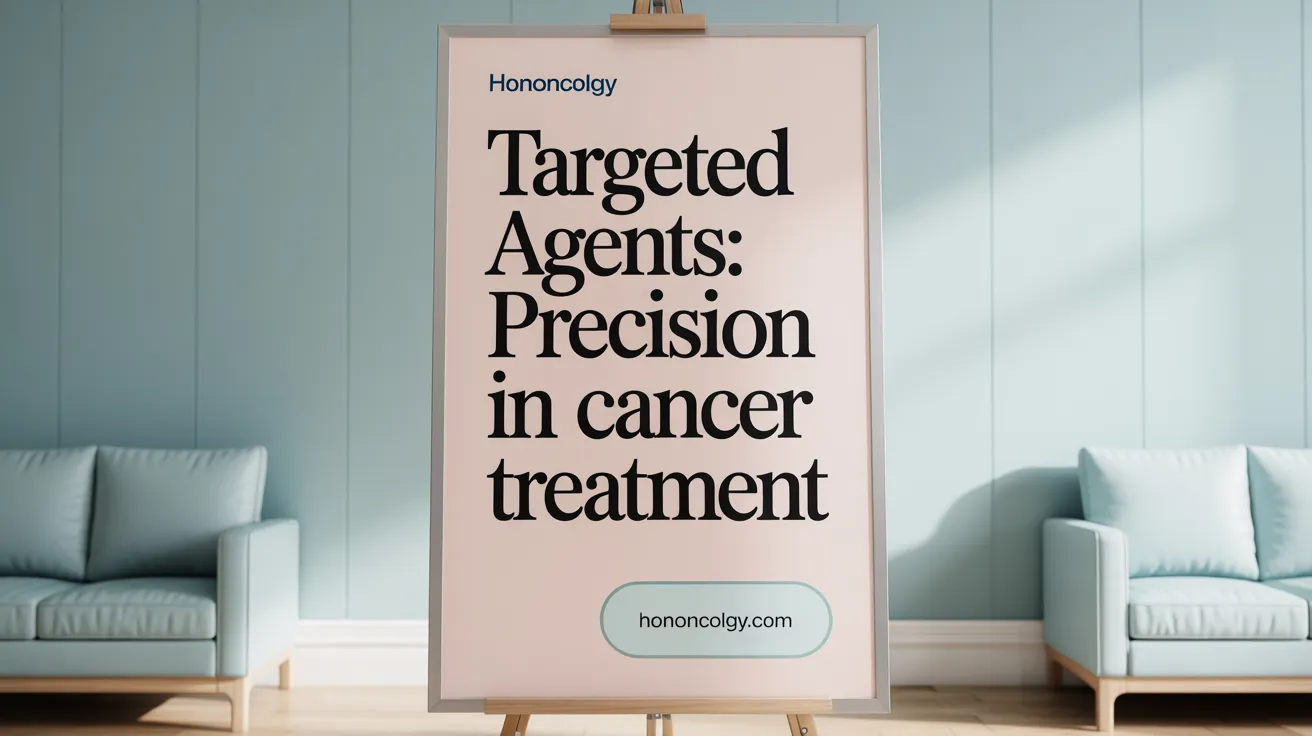
Examples such as trastuzumab, lapatinib, pertuzumab
Targeted chemotherapy agents have transformed cancer treatment by focusing on specific molecular abnormalities. Trastuzumab (Herceptin®) binds to the HER2 receptor, overexpressed in certain breast cancers, greatly enhancing treatment specificity and reducing toxicity compared to traditional chemotherapy. Lapatinib, an oral tyrosine kinase inhibitor, targets both HER2 and EGFR, effectively crossing the blood-brain barrier to treat HER2-positive breast cancer with brain metastases. Pertuzumab, a monoclonal antibody, disrupts HER2 receptor dimerization, providing another potent option targeting the same pathway.
Combination strategies improving progression-free survival
Combining targeted agents can significantly improve progression-free survival in patients. For example, dual therapy with trastuzumab and lapatinib has demonstrated superior clinical efficacy and an acceptable safety profile in heavily pretreated HER2-positive metastatic breast cancer patients. Phase III trials confirmed that this combination prolongs progression-free survival and improves overall response rates compared to lapatinib alone, highlighting the benefit of multi-drug targeted approaches.
Safety profiles and reduced side effects compared to traditional chemotherapy
Targeted therapies generally show favorable safety profiles, causing fewer off-target toxicities than traditional cytotoxic chemotherapy. By acting specifically on cancer cell receptors, agents like trastuzumab and lapatinib minimize damage to healthy tissue. Supportive treatments, including anti-emetics and growth factors, further improve tolerability. This targeted approach reduces common chemotherapy side effects such as nausea, immunosuppression, and hair loss, enhancing patient quality of life.
Molecular testing to identify candidates
Molecular profiling is essential to determine patient eligibility for targeted chemotherapy. Tests identifying HER2 overexpression or mutations in EGFR guide therapeutic decisions, ensuring that these agents are used where they are most likely to be effective. Multi-gene assays such as Oncotype DX assay and MammaPrint assay help tailor chemotherapy and targeted treatments by predicting recurrence risk and therapy benefit, promoting personalized care and optimizing outcomes.
Supportive Care Advances Complementing Low-Dose Chemotherapy

How do supportive care agents improve treatment tolerability?
Supportive care agents such as anti-emetics, growth factors, and bone health medications play crucial roles in improving cancer treatment tolerability. Anti-emetics like 5-HT3 receptor antagonists and NK-1 antagonists help prevent chemotherapy-induced nausea and vomiting, thereby enhancing patient comfort during treatment. Growth factors, including filgrastim and pegfilgrastim, support blood cell production to reduce the risk of infections and anemia that often accompany chemotherapy. Bone health agents, such as bisphosphonates like zoledronic acid, protect against skeletal-related complications in patients receiving therapies that may weaken bones (innovations in chemotherapy.
How has supportive care improved patient outcomes?
By mitigating treatment-related side effects and complications, supportive care improves patients' quality of life and helps maintain adherence to chemotherapy regimens. The enhanced tolerability allows patients, particularly those on low-dose chemotherapy protocols, to sustain treatment over longer periods without debilitating adverse effects. Improved management of symptoms and side effects reduces hospitalizations and healthcare costs, ultimately contributing to better overall outcomes and survival rates (efforts to lower cancer drug doses.
What is the role of multi-gene assays in chemotherapy personalization?
Multi-gene assays such as Oncotype DX and MammaPrint have revolutionized chemotherapy tailoring by evaluating the genetic expression profiles of tumors. These tests predict the risk of cancer recurrence and the likely benefit of chemotherapy in individual patients. This precision allows clinicians to customize chemotherapy dosage and determine whether patients can safely receive lower or adjusted doses without compromising efficacy. Integrating such assays supports personalized treatment plans that balance maximal therapeutic effect with minimized toxicity (innovative chemotherapy agents.
How is supportive care integrated with low-dose chemotherapy strategies?
Supportive care is integral to the success of low-dose chemotherapy protocols by addressing side effects and supporting patient resilience. Combining reduced-dose chemotherapy with advancements like anti-emetics, growth factors, and bone-preserving agents enables clinicians to optimize dosing schedules. This integration allows for prolonged treatment durations and improved immune function, enhancing the effectiveness of both chemotherapy and concurrent immunotherapies. Moreover, personalized dosing informed by biomarkers ensures that patients derive maximum benefit with fewer adverse events, aligning with ongoing efforts in dose optimization and patient-centered care.
Integrating Personalized Medicine and Precision Oncology

How does genomic profiling guide targeted therapies in cancer treatment?
Genomic profiling analyzes the genetic makeup of tumors to identify specific mutations driving cancer growth. This information allows clinicians to select targeted therapies tailored to the tumor's molecular characteristics, enhancing treatment efficacy and minimizing side effects. For example, treatments targeting HER2 overexpression in breast cancer or EGFR mutations in lung cancer have improved survival rates significantly.
How are AI and computational biology used to optimize cancer treatment?
Artificial intelligence (AI) and computational biology tools accelerate drug discovery and treatment personalization. AI models analyze vast datasets, including patient genomics and tumor characteristics, to predict drug responses and identify optimal multi-drug regimens. Computational methods also help in designing multi-target cancer therapies that simultaneously inhibit multiple cancer pathways, improving outcomes and overcoming resistance.
What biomarkers are used for monitoring treatment response and resistance?
Biomarkers such as circulating tumor DNA (ctDNA), protein expression levels (e.g., PD-L1), and receptor occupancy measures are critical for assessing treatment efficacy and detecting early resistance. Continuous monitoring using these biomarkers enables timely treatment adjustments, improving long-term outcomes.
How do multi-omics approaches contribute to individualized cancer treatment protocols?
Multi-omics integrates genomics, transcriptomics, proteomics, and metabolomics data to provide a comprehensive view of tumor biology. This holistic approach helps identify novel targets, predict therapy responses, and tailor treatment protocols to the individual patient's tumor profile. Advances in single-cell sequencing and spatial transcriptomics further refine personalized therapy strategies by resolving tumor heterogeneity.
| Aspect | Application | Impact |
|---|---|---|
| Genomic Profiling | Mutation-driven targeted therapies | Higher efficacy, fewer side effects |
| AI & Computational Biology | Drug discovery & dose optimization | Rapid personalized regimen development |
| Biomarkers | Monitoring treatment response & resistance | Early detection of resistance, better adjustments |
| Multi-omics | Holistic tumor profiling & novel target identification | Customized therapeutic strategies |
Case Advances: Clinical Outcomes from Low-Dose Multi-Drug Strategies
Recent clinical trial results supporting improved survival and quality of life
Low-dose multi-drug chemotherapy strategies combined with immunotherapy have demonstrated promising improvements in both survival rates and patient quality of life. Unlike traditional high-dose regimens, these protocols aim to balance effective tumor control while minimizing severe toxicities. For more on low-dose multi-drug chemotherapy strategies and dose optimization in cancer drug development.
Examples from NSCLC, breast, and other cancers
A recent phase III trial investigating low-dose nivolumab (40 mg) combined with standard chemotherapy in non-small cell lung cancer (NSCLC) patients showed encouraging progression-free survival benefits alongside reduced adverse events. In breast cancer, targeted drugs like lapatinib combined with trastuzumab have improved progression-free survival with manageable safety profiles. For resectable NSCLC, low-dose platinum chemotherapy followed by delayed immunotherapy resulted in a 73.7% objective response rate with notable tumor downstaging. These findings align with innovations in targeted chemotherapy agents and low-dose chemotherapy clinical trials.
Pathologic and molecular markers indicating tumor response
Tumor responses have been measured by clinical endpoints such as major pathologic response (47.4%) and pathologic complete response (31.6%) rates in low-dose chemo-immunotherapy trials. Molecular markers such as circulating tumor DNA (ctDNA) levels declined as treatments progressed, evidencing reduced tumor burden. Enhanced T-cell receptor (TCR) clonal expansion in tumors suggests an activated immune response contributing to effectiveness. For detailed insights, see research on chemo-immunotherapy and immune activation and biomarkers for multi-target cancer therapy.
Reduced grade 3 and 4 adverse events
Low-dose regimens consistently show lower incidence of severe (Grade 3 or 4) toxicities. For example, in NSCLC studies using metronomic chemotherapy with immunotherapy, only one Grade 3 adverse event was reported, highlighting improved tolerability. The diminished toxicity profile supports long-term treatment adherence and better patient quality of life. For additional information on dose optimization and toxicity management and metronomic chemotherapy benefits.
Combating Drug Resistance Through Multi-Target and Low-Dose Approaches
What are the mechanisms of resistance in cancer cells?
Cancer cells develop resistance to therapies through various mechanisms, including genetic mutations that alter drug targets, activation of alternative signaling pathways, and clonal heterogeneity within tumors. These adaptations enable cancer cells to survive despite conventional treatments like chemotherapy or single-target drugs. For detailed insights, see multi-target cancer therapies.
Why is attacking multiple pathways simultaneously beneficial?
Targeting multiple cancer pathways at once is advantageous because it addresses the complexity and redundancy of tumor survival mechanisms. Multi-target drugs (MTDLs) and combination regimens inhibit several critical pathways, such as receptor tyrosine kinases (EGFR, HER2, VEGFR) and signaling cascades like JAK/STAT and NF-κB. This comprehensive approach reduces the chance of cancer cells circumventing therapy via alternate routes.
How do multi-target strategies reduce the emergence of resistant clones?
By simultaneously suppressing diverse oncogenic drivers, multi-target therapies limit the survival of resistant subpopulations within heterogeneous tumors. This reduces clonal expansion of resistant cells, delays resistance onset, and lowers the need for toxic dose escalation. Multi-target drugs like imatinib, sorafenib, and lapatinib exemplify this by effectively controlling various cancers through broad pathway inhibition, as reviewed in FDA-approved multi-target cancer drugs.
What are some examples of multi-target kinase inhibitors and novel agents?
Several FDA-approved multi-target kinase inhibitors have transformed cancer treatment, including:
| Drug | Targets | Cancer Types |
|---|---|---|
| Imatinib | BCR-ABL, PDGFR | Chronic myeloid leukemia, GIST |
| Lapatinib | HER2, EGFR | HER2-positive breast cancer |
| Sorafenib | VEGFR, PDGFR, RAF kinase | Liver, kidney cancers |
Innovative agents like KCL-HO-1i drug discovery target tumor microenvironment components, specifically macrophage-produced heme oxygenase-1 (HO-1), to overcome immune evasion and chemotherapy resistance. This novel immunomodulatory drug, designed as a daily oral pill, has shown promise in preclinical models by disrupting resistance mechanisms and enhancing chemotherapy effectiveness.
How does dose optimization complement these strategies?
Low-dose or metronomic chemotherapy focuses on delivering frequent, smaller doses that normalize tumor vasculature and stimulate immune responses, further reducing resistance development and side effects. Combining multi-target drugs with dose-optimized regimens holds potential to improve efficacy, reduce toxicity, and delay resistance progression in cancer therapy. For more information, see Dose optimization in cancer drug development and Low-dose chemotherapy protocol.
Experimental Drugs Enhancing Low-Dose Multi-Drug Protocols
What is KCL-HO-1i and how does it target the tumor microenvironment?
KCL-HO-1i is an innovative experimental drug designed to overcome chemotherapy resistance by targeting heme oxygenase-1 (HO-1) produced by macrophages within the tumor microenvironment. These macrophages create a barrier that prevents T cells from penetrating the tumor, aiding immune evasion. By inhibiting HO-1, KCL-HO-1i helps dismantle this barrier, facilitating immune system access to cancer cells.
How does KCL-HO-1i enhance chemotherapy response through immunomodulation?
Preclinical studies demonstrated that KCL-HO-1i boosts chemotherapy effectiveness, including in tumors resistant to traditional treatments. The drug's mechanism involves modulating the tumor microenvironment to improve T cell infiltration. This immunomodulatory effect synergizes with chemotherapy, potentially allowing effective responses at lower drug doses, thus minimizing toxicity (low-dose multi-drug chemotherapy strategies, Chemo-Immunotherapy in Cancer Treatment.
What is the current development status and upcoming clinical trials for KCL-HO-1i?
Developed with support from the Medical Research Council and interdisciplinary expertise from King’s College London cancer research, KCL-HO-1i is planned to enter clinical trials within two years. These trials will evaluate its safety and effectiveness when combined with established chemotherapies, moving towards integration into cancer treatment protocols.
What are the implications for future combinational regimens?
KCL-HO-1i exemplifies a promising approach integrating immunomodulation with low-dose chemotherapy protocols and low-dose multi-drug chemotherapy protocols. This strategy aims to improve therapeutic outcomes by enhancing immune response while reducing drug-related side effects and resistance. The availability of a daily oral formulation facilitates outpatient use, increasing patient convenience and adherence. Such innovations could shape next-generation combinational cancer treatments focused on precision, synergy, and tolerability (Chemo-Immunotherapy in Cancer Treatment.
Challenges in Developing Low-Dose Multi-Drug Regimens
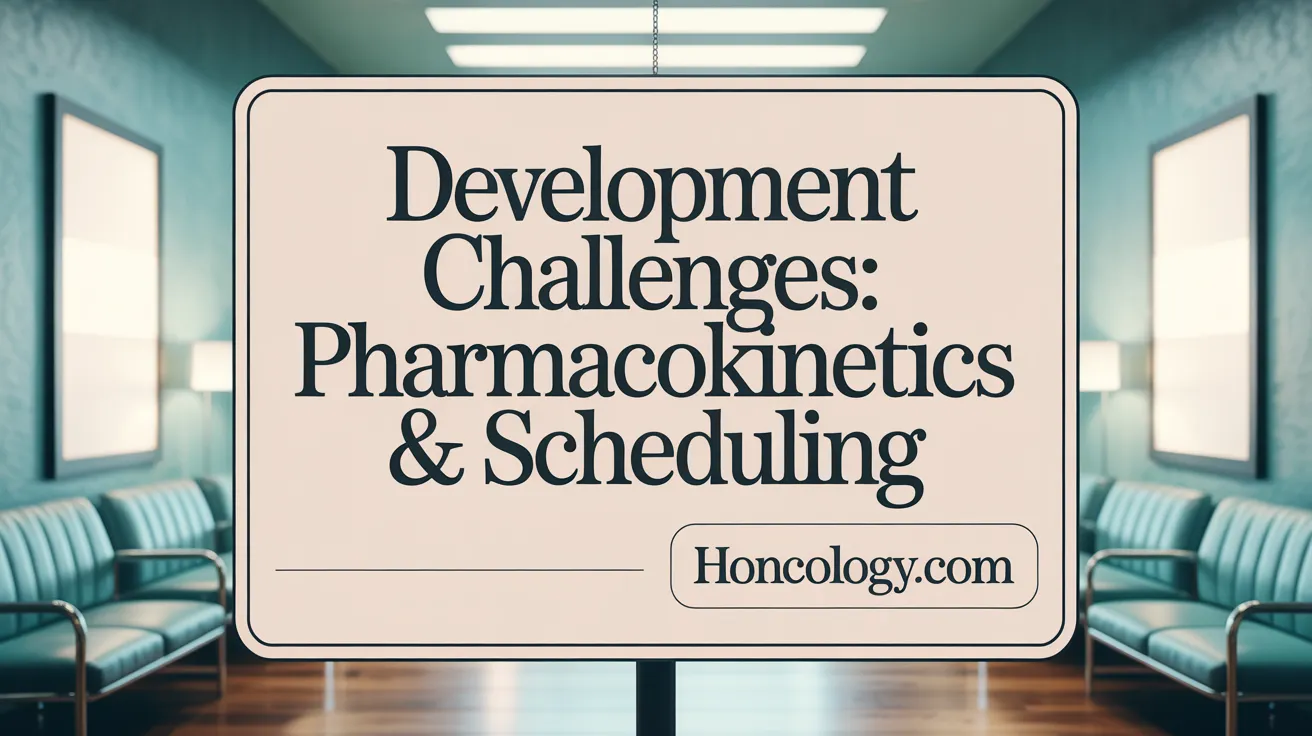
How are pharmacokinetics and toxicity balanced in low-dose multi-drug therapies?
Balancing pharmacokinetics and toxicity is a significant challenge when developing low-dose multi-drug regimens. Precise dosing is required to ensure that each drug reaches effective concentrations without causing cumulative or overlapping toxicities. Pharmacokinetic/pharmacodynamic (PK/PD) modeling plays a pivotal role in understanding drug absorption, distribution, metabolism, and elimination, thereby guiding optimal dosing strategies. Because multi-drug protocols combine agents with different half-lives and clearance rates, harmonizing these profiles is complex but critical to maintaining efficacy while reducing adverse effects.
What complexities arise in sequencing and scheduling these drug combinations?
Optimal sequencing and scheduling of low-dose drug combinations pose another difficulty. The timing of each drug's administration affects synergistic interactions and immune modulation within the tumor microenvironment. For instance, studies have shown that sequential rather than concurrent drug delivery can lower total drug exposure without sacrificing effectiveness. Additionally, the tumor’s recovery period dictates how frequently doses can be given, as intervals exceeding 40% of this time may lead to relapse. Therefore, designing schedules that account for tumor biology, immunogenic effects, and vascular normalization is essential.
Why is biomarker identification and patient stratification necessary?
Identifying predictive biomarkers is crucial for stratifying patients who are most likely to benefit from specific low-dose multi-drug regimens. Biomarkers help monitor target engagement and pharmacodynamic responses, allowing doses to be tailored for maximum benefit and minimal toxicity. Patient-reported outcomes and molecular profiles provide insight into tolerability and efficacy, supporting a personalized medicine approach. Without robust biomarkers, it is challenging to optimize treatment for diverse patient populations and tumor heterogeneity.
How does the need for mechanistic and translational research impact development?
Mechanistic understanding of how low-dose multi-drug therapies modulate cancer cells, immune responses, and the tumor microenvironment remains limited. Many clinical trials currently lack comprehensive translational endpoints and detailed mechanistic analyses. Advancements in single-cell sequencing and spatial transcriptomics could reveal how these regimens influence cellular populations and immune activation, guiding improved combinations. Further research is needed to overcome resistance mechanisms, reduce toxicity, and enhance durable responses, ultimately accelerating clinical translation of these promising therapies.
Role of Immune System Activation in Low-Dose Chemotherapy Efficacy

Activation of NK Cells and Upregulation of Activating Ligands
Low-dose chemotherapy not only targets cancer cells directly but also stimulates the immune system, particularly natural killer (NK) cells. Chemotherapy induces upregulation of ligands for activating NK cell receptors, such as NKG2D, on tumor cells. This enhances NK cell recognition and cytotoxic attack against cancer cells, increasing the overall anti-tumor immune response. For more details on Chemotherapy-Induced Activation of NK Cells and Immune Modulation.
DNA Damage Response Pathways Triggering Immune Recognition
Chemotherapy-induced DNA damage activates intracellular pathways—namely ATM, ATR, and p53—that contribute to immune activation. These pathways increase the expression of NK cell-activating ligands and promote immunogenic cell death (ICD), releasing danger signals that alert and activate immune cells, including dendritic cells and cytotoxic T lymphocytes. Learn more about Immunogenic Cell Death and Danger-Associated Molecular Patterns (DAMPs) in Chemo-Immunotherapy.
Synergies with Immune Checkpoint Blockade
Low-dose chemotherapy can enhance the efficacy of immune checkpoint inhibitors by modulating the tumor microenvironment. For example, chemotherapy-induced upregulation of PD-L1 on tumor cells provides a rationale for combining chemotherapy with PD-1/PD-L1 blockade. This combined approach has resulted in improved response rates in cancers such as non-small cell lung cancer and triple-negative breast cancer. See further insights on Combination Cancer Therapies and Immune Checkpoint Inhibitors and Targeted Cancer Therapies Including Immunotherapies.
Modulation of Tumor Microenvironment
Metronomic or low-dose chemotherapy helps reduce immunosuppressive cells, including regulatory T cells (Tregs) and myeloid-derived suppressor cells (MDSCs), within the tumor microenvironment modulation. By alleviating immunosuppression and enhancing effector T cell and NK cell activities, this modulation supports a more favorable immune milieu that promotes durable tumor control and diminishes resistance to therapy. For comprehensive discussions on Metronomic Chemotherapy and Tumor Microenvironment Modulation and Synergistic Effects of Chemo-Immunotherapy.
This multifaceted immune activation explains why low-dose chemotherapy regimens can offer enhanced efficacy and tolerability, making chemo-immunotherapy an increasingly promising avenue in cancer treatment.
Radiotherapy and Low-Dose Chemotherapy: Complementary Innovations
How does low-dose chemotherapy enhance radiotherapy?
Low-dose chemotherapy, also known as metronomic chemotherapy, uses frequent administration of low drug doses to minimize toxicity while maximizing therapeutic effects. One important function is its ability to act as a radiosensitizer by normalizing tumor blood vessels, improving oxygen delivery and drug penetration within the tumor microenvironment. This vascular normalization enhances radiotherapy efficacy by increasing the tumor's sensitivity to radiation and promoting immune system activity.
What are the recent advances in hypofractionation and altered fractionation radiotherapy?
Radiotherapy techniques have evolved beyond traditional schedules with the adoption of hypofractionated and altered fractionation regimens. Hypofractionation delivers higher radiation doses in fewer sessions, improving patient convenience and maintaining effectiveness. Altered fractionation strategies such as hyperfractionation and accelerated fractionation distribute daily doses differently to increase tumor control and survival, particularly in head and neck cancers. These approaches are part of innovations in radiation therapy that aim at enhancing treatment precision and patient quality of life.
How are targeted agents and immunotherapies integrated with radiotherapy?
Combining radiotherapy with targeted therapies like EGFR inhibitors and immune checkpoint inhibitors has shown promise in improving cancer control. For example, adding agents such as cetuximab can enhance radiosensitivity, especially for patients unable to tolerate high-dose chemotherapy. Ongoing clinical trials are evaluating these immunotherapies alongside radiation to leverage synergistic antitumor immune responses for durable control, reflecting advances in immunotherapy integration.
What are the benefits in terms of reduced toxicities and patient convenience?
These innovations collectively reduce side effects traditionally associated with chemotherapy and radiotherapy. Low-dose chemotherapy minimizes systemic toxicities and improves long-term tolerability, aligning with dose optimization strategies in cancer drug development. Hypofractionated radiotherapy decreases the number of hospital visits, enhancing patient convenience and quality of life. Together, these advances represent a shift toward personalized, less burdensome cancer management while maintaining or improving therapeutic outcomes.
Patient-Centered Approaches in Low-Dose Multi-Drug Protocols
Incorporation of patient-reported outcomes in trials
Modern cancer drug development increasingly values patient-reported outcomes (PROs) as essential measures in dose optimization trials. PROs provide insights into patients' experiences of symptoms and side effects over time, beyond traditional clinical toxicity assessments. This data supports identifying doses that balance efficacy with tolerability, facilitating safer and more comfortable treatment journeys.
Flexible dosing strategies personalized to tolerability
The shift from maximum tolerated dose (MTD) to optimal biological dose (OBD) underscores tailored dosing approaches. Personalized dosing adjusts the intensity of low-dose, multi-drug regimens according to individual patient tolerability and pharmacodynamics, often guided by Pharmacokinetic/pharmacodynamic (PK/PD) modeling and biomarker data. This flexibility helps minimize adverse effects while maintaining therapeutic benefits.
Quality of life improvements with reduced toxicity
Low-dose chemotherapy protocols, such as metronomic chemotherapy, tend to result in fewer side effects compared to conventional high-dose treatments. Patients report improvements in quality of life, including reduced fatigue, nausea, and overall treatment burden. Reduced toxicity also translates into better adherence and prolonged treatment courses, critical for combination therapies including multi-targeted and immunotherapy-inclusive regimens.
Shared decision-making between clinicians and patients
Engaging patients as active partners in treatment decisions is integral to personalized low-dose multi-drug therapies. Transparent discussion about dose possibilities, potential side effects, and expected benefits empowers patients to participate in their care plans. Such communication enhances patient satisfaction, adherence, and outcomes by aligning treatments with patient preferences and lifestyles.
New Technologies Driving Innovation in Cancer Treatment Methods
mRNA Vaccines and Personalized Immunotherapies
Personalized cancer vaccines using mRNA cancer vaccines technology have emerged as a revolutionary immunotherapy approach. These vaccines are designed based on the genetic profile of individual tumors, aiming to prime the immune system to target cancer cells specifically. Trials with mRNA cancer vaccines have shown promise in activating potent immune responses, reducing recurrence risk while minimizing side effects. These vaccines are being trialed in cancers such as melanoma, bladder, and prostate, potentially becoming widely accessible within this decade.
Use of AI and Machine Learning for Early Detection and Risk Profiling
Artificial intelligence (AI) and machine learning algorithms are increasingly integrated into cancer care to enhance early detection and precision risk profiling. AI systems analyze medical images and patient data to identify subtle diagnostic features early, as demonstrated by breath-based diagnostic tools and lung cancer risk prediction models forecasting risk years in advance. In developing regions, AI supports resource-efficient imaging analysis to detect cancers like breast cancer earlier than traditional methods.
Liquid Biopsies for Monitoring Tumor Dynamics
Liquid biopsies represent a less invasive diagnostic technique analyzing blood samples to detect circulating tumor DNA (ctDNA) or tumor-derived extracellular vesicles. This approach allows for ongoing monitoring of tumor burden, genetic mutations, and treatment response without repeated tissue biopsies. Notably, liquid biopsies enable early detection and dynamic monitoring during treatment, informing personalized adjustments in therapeutic strategies.
Novel Imaging Tracers Guiding Therapy
Advancements in imaging include new radiotracers targeting specific tumor markers, such as DLL3 in lung and prostate cancers. These tracers improve the accuracy of tumor detection and help guide targeted therapies more precisely. Enhanced imaging facilitates tailored treatment plans and early assessment of therapeutic efficacy, improving outcomes while reducing exposure to unnecessary treatments. Examples include the use of imaging tracers like [89Zr]Zr-DFO-SC16.56 for lung and prostate cancers.
These innovative technologies synergize to provide more targeted, effective, and patient-friendly cancer management solutions, marking a significant leap forward in personalized oncology care.
Future Perspectives: AI and Computational Biology in Protocol Development

Design of multi-target drugs and dosing regimens through AI
Artificial intelligence (AI) is revolutionizing cancer drug development by enabling the design of multi-target drugs (MTDLs) that simultaneously inhibit multiple pathways, improving efficacy and limiting resistance. Strategies such as pharmacophore fusion, combining, and linking are enhanced by AI-based multi-target drug development, facilitating the discovery of compounds with optimized multi-target profiles. Additionally, AI supports the identification and optimization of dosing regimens by analyzing pharmacokinetic/pharmacodynamic (PK/PD) modeling, enhancing both efficacy and tolerability while minimizing toxicity.
Integration of single-cell and spatial transcriptomics data
Cutting-edge technologies like single-cell sequencing and spatial transcriptomics are increasingly being integrated with computational biology in drug design tools to provide a detailed understanding of the tumor microenvironment. These high-resolution data inform the cellular and molecular heterogeneity within tumors, guiding the rational design of chemo-immunotherapy regimens and personalized dosing strategies. By mapping immune cell distributions and tumor cell states, computational models predict responses to chemo-immunotherapy regimens and help optimize treatment timing and dose.
Predictive modeling for patient-specific responses
Machine learning in multidrug cancer therapy algorithms combined with multi-omics data facilitate predictive modeling that forecasts individual patient responses to complex multi-drug protocols. Models incorporate tumor genetics, immune profiling, and drug interactions to tailor therapies optimizing treatment effectiveness. This approach enables safer dose minimization without compromising therapeutic outcomes, addressing challenges like drug resistance and variation in drug metabolism.
Potential to streamline clinical trial efficiency
AI and computational biology are streamlining clinical trial designs by enabling dose-response simulations and adaptive trial strategies. Bayesian optimization frameworks and tumor-on-a-chip platforms reduce the number of experimental runs required to identify effective drug combinations and dosage schedules. This reduces patient exposure to suboptimal doses and accelerates the identification of optimal biological doses, aligning with regulatory initiatives like FDA's Project Optimus. The integration of real-time biomarker feedback with AI-guided dosing promises enhanced clinical precision and faster drug approval timelines.
Conclusion: Transforming Cancer Care with Low-Dose Multi-Drug Chemotherapy
Leveraging Low-Dose Multi-Target Strategies for Enhanced Cancer Treatment
Low-dose multi-drug chemotherapy represents a transformative approach in oncology, combining multiple agents targeting varied pathways to overcome resistance and tumor heterogeneity. This method not only reduces toxicity and adverse side effects associated with conventional high-dose treatments but also improves treatment tolerability and patient quality of life. By normalizing tumor vasculature and boosting immune activation, low-dose protocols provide a dual mechanism to attack cancer while preserving healthy tissue.
Regulatory Advances and Clinical Trials Driving Progress
Innovative frameworks such as FDA’s Project Optimus emphasize optimized dosing strategies that balance maximum efficacy with minimal toxicity, moving away from traditional maximum tolerated dose models. Current clinical trials focus on randomized dose-finding, incorporating biomarkers and patient-reported outcomes to tailor therapy. Studies with agents like low-dose Nivolumab and novel combinations underscore the trend toward precise dosing aimed at improved survival and reduced side effects.
The Path Towards Personalized, Safer, and More Effective Therapies
Integration of computational modeling, AI-driven drug design, and personalized immunotherapy enhances the specificity of multi-target treatments. Combining targeted chemotherapy with immunotherapy harnesses immune system activation through immunogenic cell death and modulation of the tumor microenvironment, promoting sustained anti-tumor responses. Personalized regimens consider tumor genetics, pharmacodynamics, and immune profiles to maximize outcomes while minimizing unnecessary toxicity.
Embracing Ongoing Research and Patient-Centered Innovation
Continued exploration is essential to refine these low-dose multi-drug protocols, ensuring accessibility and benefiting diverse patient populations. Innovations such as advanced imaging for vascular normalization, machine learning in regimen optimization, and spatial transcriptomics will deepen mechanistic understanding. This patient-focused evolution in cancer therapy demands collaborative efforts in research, regulatory guidance, and clinical practice to deliver safer, more effective, and tailored cancer care.





.png)


.png)
.png)


